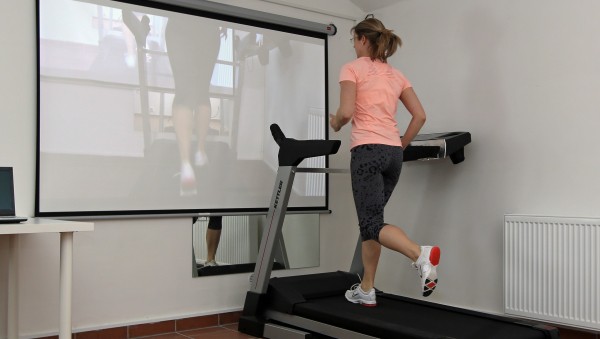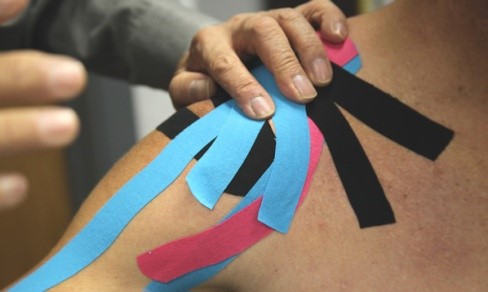SPORTS PHYSIOTHERAPY – BE BALANCED – PRAGUE 6
Chronic pain or protracted sports injuries are frequently caused by a lack of coordination which is often repeated when playing sports. The treatment of coordination problems often helps to both eliminate such pain and significantly improve your running style.
RUNNING GAIT ANALYSIS AND IMPROVING YOUR RUNNING TECHINQUE
A full body video gait analysis provides both an overview of the interactions underway within the body and a detailed evaluation of how movements in one area may be contributing to tissue overload in another. We believe that it is very important to consider the mechanics of the hips and the trunk of the body since they play a vital role in controlling distal movements in the lower limbs.

– through the use of our special technology, you can observe your running gait right in front of your eyes!
– our experienced physiotherapists will take full care of you and help you to understand the source of pain
– you will learn how to activate and make maximum use of other parts of your body and receive expert advice on how to improve your running style with the help of home exercising
In many cases it is possible to reduce or even eliminate pain as early as during the analysis stage through being able to observe at first hand those parts of the body that are being overloaded.
Video gait analysis: 60 minutes, CZK 1200
What are we dealing with?
- Achilles tendon pain, ankle and heel pain, shin splints
- Runner´s knee pain
- Hip-joint pain, groin pain
- Back pain during running
- Intervertebral disc herniation
- Decreased running technique efficiency
Kinesiotape – the body band-aid, not just for athletes!
Many of you probably have seen this colorful method of taping on athletes, children or people on the streets or at your office and wondered about where this tape came from and what it does. Kinesio-taping is more than what meets the eye and is now widely used in rehabilitation because of its ability to create various effects on the body.
Kinesio-taping is a very useful technique in rehabilitation. It has a wide variety of uses, and its range of effects makes it usable for many conditions and in almost every field of physiotherapy. It can provide an effect when used alone, for example in aiding support in movement, effecting muscle tone, or lymphatic drainage and its effect can be maximized when used in conjunction with other therapies, such as manual techniques, therapeutic exercises, massage, hydrotherapy, etc.
 Kinesiotaping was developed by a Japanese chiropractor in the 1970’s, Dr. Kenzo Kazem where he used it during his performance in the Olympics in Seoul in 1988. After that it became widely used in Japan, then became more publicly aware in the field of physiotherapy.
Kinesiotaping was developed by a Japanese chiropractor in the 1970’s, Dr. Kenzo Kazem where he used it during his performance in the Olympics in Seoul in 1988. After that it became widely used in Japan, then became more publicly aware in the field of physiotherapy.
The method uses a specific elastic tape made from cotton which is breathable and waterproof. It has an acrylic adhevise that activates from heat (which is why, in application, the therapist must rub on the tape to cause friction and heat). The successfulness of the method relies on the fact that the tape has similar weight and thickness as human skin therefore enhances its effect. The elasticity (130-140%) of the tape allows for it to mimic the qualities of the skin, and it isn’t restrictive (such as other types of tape used in rehabilitation like the white sports tape which gives more immobilization effects).
How it works
When the tape is applied to the skin, it creates convolutions in it, which causes a lift of the skin. This lifting creates a higher interstitial space. The result of this is a decrease in pressure on the tissues below the skin (neural and sensory receptors) and this decrease is the cause of effects such as relief of pain, increase of flow in the lymphatic channels, and release of soft tissue as well (similar effect brought about by soft tissue techniques).
Kinesiotaping benefits:
- Increase flow in lymphatic system
- Alleviate pain by decreasing pressure on pain receptors
- Releases skin/fascia
- Stimulation of weakened muscles
- Prevention of overuse of muscles (opposite of stimulation effect)
- Support of joints and muscles during movement
Kinesiotaping Uses:
At BeBalanced, we use Kinesiotaping for patients after sport injuries such as muscle tears and sprains (example in the calf muscles in cyclists), for decreasing swelling in affected areas, for decreasing pain and/or stimulating specific muscles, for postural correction or even for muscle activation in weaker children and various others.
Taping is not a ‘’do-it-yourself’’ method but is indeed applied only after a thorough evaluation of the client and what the therapist wants the K-tape to achieve (which area to effect, which muscle, what effect is wanted, etc.) according to the goal of therapy, and because of its specific principles only trained professionals with knowledge of human biomechanics and anatomy are capable of carrying out the technique correctly and safely.
Just as I tell my friends, don’t be fooled by how easy the Youtube videos make it look, but please don’t try to apply it alone without the guidance or instruction of a trained physiotherapist! Negative effects can be induced from incorrect application and symptoms could worsen.
Contact us if you have any further questions or visit us at our center, and we’ll put a tape on that!:-)
CYCLING ANALYSIS
Ride your bike to our clinic in Prague 6 and we will conduct a full analysis of your riding position and determine what is the source of pain (e.g. knee pain during cycling). With the help  of our cycling trainer, we will analyse the saddle and pedal positions and foot placement, ensure that you do not pedal in an asymmetric position and correct your overall seating position while cycling. This often significantly reduces the risk of injury and maximises your riding potential via enhanced efficiency and comfort.
of our cycling trainer, we will analyse the saddle and pedal positions and foot placement, ensure that you do not pedal in an asymmetric position and correct your overall seating position while cycling. This often significantly reduces the risk of injury and maximises your riding potential via enhanced efficiency and comfort.
If it is not convenient to bring your own bike with you, we are able to assess your cycling performance on the clinic’s Wattbike indoor bike trainer. A special performance monitor displays a broad range of parameters including your pedalling technique and how you can optimise the powering of the pedals in each revolution, pedal momentum quality, etc.
.
